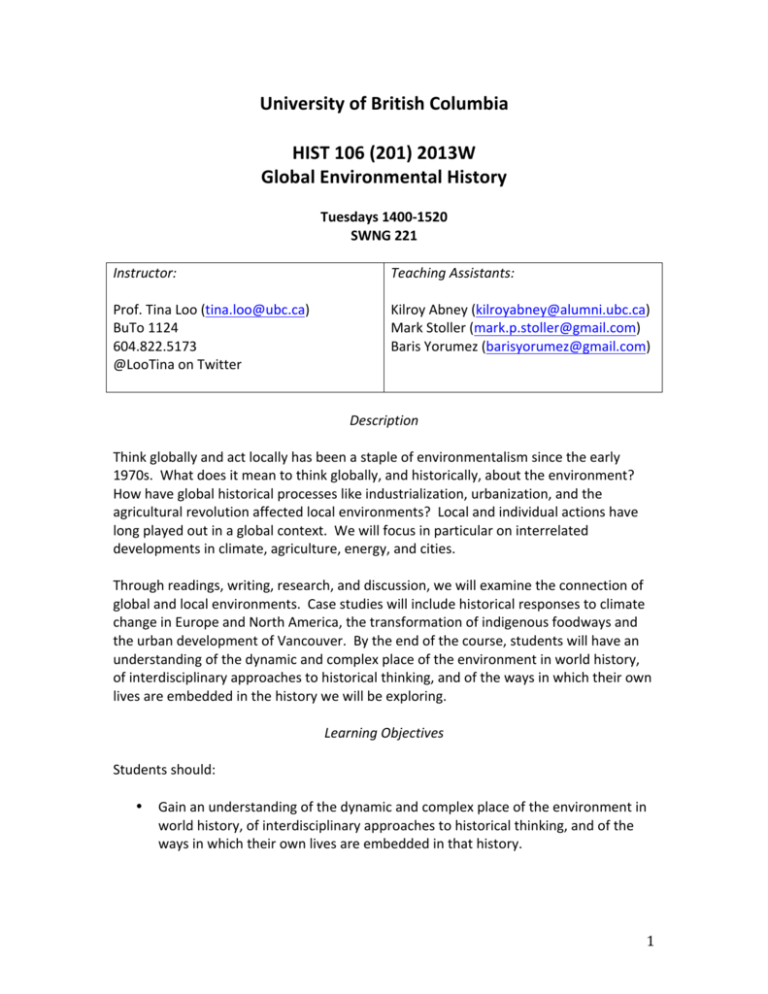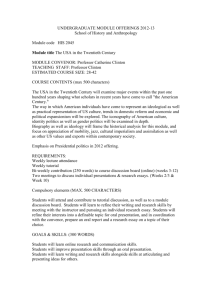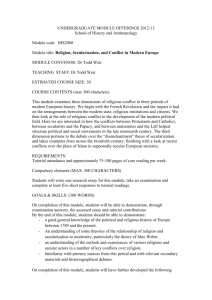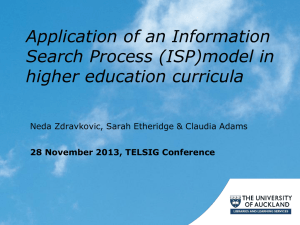Global Environmental History - UBC Blogs
advertisement

University of British Columbia HIST 106 (201) 2013W Global Environmental History Tuesdays 1400-­‐1520 SWNG 221 Instructor: Teaching Assistants: Prof. Tina Loo (tina.loo@ubc.ca) Kilroy Abney (kilroyabney@alumni.ubc.ca) BuTo 1124 Mark Stoller (mark.p.stoller@gmail.com) 604.822.5173 Baris Yorumez (barisyorumez@gmail.com) @LooTina on Twitter Description Think globally and act locally has been a staple of environmentalism since the early 1970s. What does it mean to think globally, and historically, about the environment? How have global historical processes like industrialization, urbanization, and the agricultural revolution affected local environments? Local and individual actions have long played out in a global context. We will focus in particular on interrelated developments in climate, agriculture, energy, and cities. Through readings, writing, research, and discussion, we will examine the connection of global and local environments. Case studies will include historical responses to climate change in Europe and North America, the transformation of indigenous foodways and the urban development of Vancouver. By the end of the course, students will have an understanding of the dynamic and complex place of the environment in world history, of interdisciplinary approaches to historical thinking, and of the ways in which their own lives are embedded in the history we will be exploring. Learning Objectives Students should: • Gain an understanding of the dynamic and complex place of the environment in world history, of interdisciplinary approaches to historical thinking, and of the ways in which their own lives are embedded in that history. 1 • • • • • • • Learn to situate local experience, perception, and causes of environmental change within a global context. In other words, be able to identify the global forces at play in local concerns, but also the role that local action has in constituting global environmental systems. Learn how global historical processes like industrialization, urbanization, and the agricultural revolution have affected local environments. Learn to apply particular environmental historical concepts to both historical and contemporary environmental issues. Concepts include environmental determinism/agency, urban metabolism, social construction of nature, social ecology, environmental justice, geographies of risk, and many others. Hone their humanities writing skills through the development of an argument and the use of evidence with proper citations. Engage reading material and classmates via discussion in tutorials and on blogs. Requirements and Evaluation There will be one 80-­‐minute lecture on Tuesday each week. Most weeks, there will also be an interactive online module, which you should complete before your tutorial. Your online module participation is required and part of your tutorial participation grade. Your online module participation takes the form of blog entries. You’re expected to write a blog entry in response to a particular subject and question(s). See the end of the syllabus for more information. • Regular attendance and participation in discussion during tutorials. Tutorials are an integral part of the course, and your attendance and participation will be a significant portion of your grade. • Two short essays (750-­‐1000 words each) due February 7 (by e-­‐mail) and in your tutorial the week of February 25). Details are at the end of this syllabus. Late papers will be penalized at 5 per cent per day unless otherwise arranged in advance of the due date. Scheduled final exam at the end of the term. • The grade breakdown is as follows: • Tutorial attendance and participation (in class and online) 15 per cent 2 • • Essays: 2 x 25 per cent Final exam 50 per cent 35 per cent Course Materials Most of the readings for tutorials will be available via the UBC CONNECT course website (elearning.ubc.ca). Please ensure you have a CWL (campus-­‐wide login); i.e. a UBC computer account and password that have been activated. HOWEVER, you will have to purchase one set of photocopied readings (the ones for January 28 and which will be the basis of one of your essays) at the UBC Bookstore. It’s Mike Hulme, Chapters 4 and 5 in Why We Disagree About Climate Change: Understanding Controversy, Inaction, and Opportunity (2009), 109-­‐177. Course Schedule January 7: Intro NO TUTORIALS. Sign up for your tutorial’s blog “wall.” Instructions are on the Connect site. SECTION 1: CLIMATE CHANGE January 14: The discovery of climate change ONLINE: Are you optimistic or pessimistic about the future of nature after doing the readings and interactive exercises this week? Why? TUTORIAL READINGS: “How hot will it get in my lifetime?” http://www.theguardian.com/environment/interactive/2013/sep/27/climate-­‐change-­‐ how-­‐hot-­‐lifetime-­‐interactive “Welcome to the Anthropocene” http://vimeo.com/39048998 Footprint calculator: http://www.footprintnetwork.org/en/index.php/GFN/page/calculators/ Libby Robin, Sverker Sörlin, and Paul Warde, “The Anthropocene,” in their The Future of Nature (New Haven: Yale University Press, 2013), 479-­‐481. Paul J. Crutzen and Eugene F. Stoermer, “The Anthropocene” plus Commentary by Will Steffen in L. Robin, S. Sörlin, and P. Warde, eds., The Future of Nature (New Haven: Yale University Press, 2013), 483-­‐490. 3 Johan Rockström, Will Steffen, Kevin Noone, et. al., “A Safe Operating Space for Humanity” plus Commentary by Susan Owens, in L. Robin, S. Sörlin, and P. Warde, eds., The Future of Nature (New Haven: Yale University Press, 2013), 491-­‐505. Questions for discussion: • What’s the point of a label like “the Anthropocene” and footprint calculators? • How useful is it to think of “a safe operating space for humanity”? January 21: The social meanings of climate ONLINE: Environmental determinism: “The Path to Supremacy” TUTORIAL READINGS: Franklyn Griffiths, “Camels in the Arctic? Climate Change as Inuit See It: ‘From the Inside Out’,” The Walrus, November 2007: 46-­‐61. http://www.walrusmagazine.com/articles/2007.11-­‐arctic-­‐global-­‐warming/ Mike Hulme, “Reducing the Future to Climate: A Story of Climate Determinism and Reductionism,” in L. Robin, S. Sörlin, and P. Warde, eds., The Future of Nature (2013), 506-­‐519. Questions for discussion: • What are Griffiths and Hulme arguing? • How would Franklyn Griffiths and the Inuit he spoke with respond to Mike Hulme? January 28: Why we disagree about climate change TUTORIAL READINGS (NB: There’s lots more this week but that’s because you’ll be using this material to write your first essay. Leave yourself enough time to read it.) Mike Hulme, Chapters 4 and 5 in Why We Disagree About Climate Change: Understanding Controversy, Inaction, and Opportunity (2009), 109-­‐177. NOT ONLINE; AVAILABLE AS A COURSEPACK AT THE UBC BOOKSTORE. Naomi Klein, “Capitalism vs. the Climate,” The Nation, 9 November 2011. http://www.thenation.com/article/164497/capitalism-­‐vs-­‐climate Hans Rosling, “200 Years of Global Change,” Presentation to the IPCC, September 2013. http://www.youtube.com/watch?v=grZSxoLPqXI Questions for discussion: • What do Hulme, Klein, and Rosling tell you about the challenges to doing something about climate change and how we need to work towards solutions? 4 This tutorial will get you thinking about the ESSAY you have to turn in next week. Drawing on the lectures and the readings, write an essay about how and where solutions to the climate crisis might be found. SECTION 2: AGRICULTURE February 4: Overview: agriculture and social and political transformation NO TUTORIALS: FIRST ESSAY DUE BY E-­‐MAIL TO YOUR TEACHING ASSISTANT BY FRIDAY, FEBRUARY 7 BY 5PM. However, you will be responsible for reading the following; i.e. it’s examinable material: Alfred Crosby, “The Columbian Exchange,” in his Children of the Sun: A History of Humanity’s Unappeasable Appetite for Energy (W.W. Norton & Company, 2006), 45-­‐58. February 11: Industrial Agriculture ONLINE: The Green Revolution. TUTORIAL READINGS: Michael Pollan, “An Animal’s Place,” New York Times 10 November 2002. http://www.nytimes.com/2002/11/10/magazine/an-­‐animal-­‐s-­‐ place.html?scp=2&sq=pollan&st=nyt Michael Pollan, “Power Steer,” New York Times 31 March 2002. http://www.nytimes.com/2002/03/31/magazine/power-­‐ steer.html?scp=4&sq=pollan&st=nyt Michael Pollan, “When a Crop becomes King,” New York Times 19 July, 2002. http://www.nytimes.com/2002/07/19/opinion/when-­‐a-­‐crop-­‐becomes-­‐ king.html?scp=3&sq=pollan&st=nyt Questions for discussion: • What does Michael Pollan see as the problems with industrial agriculture? • What, if any, solutions does he propose? • Is there any defense to be made for industrial agriculture? February 18: READING WEEK – NO CLASSES; WORK ON YOUR SECOND ESSAY WHICH IS DUE IN TUTORIAL THE WEEK OF FEB. 25 (See below for the essay question). February 25: Post-­‐Industrial Agriculture 5 TUTORIAL READINGS: Wendell Berry, “The Agrarian Standard,” Orion Magazine, Summer 2002. http://www.orionmagazine.org/index.php/articles/article/115/ Wendell Berry, “Renewing Husbandry,” Orion Magazine, September/October 2005. http://www.orionmagazine.org/index.php/articles/article/160/ Dick Courteau, “Horse Power,” Orion Magazine, September/October 2007. http://www.orionmagazine.org/index.php/articles/article/343/ Michael Pollan, “Mass Natural,” New York Times Magazine, 4 June 2006. http://www.nytimes.com/2006/06/04/magazine/04wwln_lede.html?sq=michael %20pollan&st=cse&scp=27&pagewanted=all Questions for discussion: • If these authors represent perspectives on post-­‐industrial agriculture, what are they? What kind of future would they like to see? • We’ll also talk about the essays. ESSAY 2 DUE IN YOUR TUTORIAL: What is the relationship of the local and the global in the critiques of industrial agriculture we’ve encountered by Pollan, Shiva, and Berry? SECTION 3: ENERGY March 4: Energy in World History: An Overview ONLINE: Harvesting energy from humans. TUTORIAL READINGS: Andrew Nikiforuk, “The Energy of Slaves,” “Slaves to Energy,” and “The New Servitude,” in his The Energy of Slaves: Oil and the New Servitude (Vancouver: Greystone, 2012), 1-­‐29; 62-­‐73. “Human Power Station,” episode 11, Series 1, Bang Goes the Theory, BBC 1, first aired 3 December 2009. http://www.youtube.com/watch?v=uVK6w1Fldxw Questions for discussion: • In what way are we slaves to energy? • Do you buy Nikiforuk’s metaphor about human slavery and energy slavery? In what ways are the arguments against ending our dependence on fossil fuels the same as the arguments against human slavery? 6 • What did you make of the BBC show? Is slavery (maybe “voluntary” slavery?) the new green energy? (After all, there are no carbon emissions from the human generators….) March 11: The Regime of Steam – and Coal ONLINE: Waking the Green Dragon: China and environmentalism TUTORIAL READINGS: Barbara Freese, “A Sort of Black Stone,” in her Coal: A Human History (Cambridge, MA: Perseus Publishing, 2003), 199-­‐232. “Journey to the End of Coal – an Interactive Documentary”: scroll down to about the middle and you’ll see where you click to view the documentary. Navigate your way through it and come prepare to talk about what you discovered about the Chinese coalmines. http://www.interactivedocumentary.net/2008/09/16/journey-­‐to-­‐the-­‐end-­‐of-­‐ coal/ Wolfgang Schivelbusch, “Railroad Space and Railroad Time,” New German Critique 14 (1978): 31-­‐40. http://www.jstor.org.ezproxy.library.ubc.ca/stable/488059 Questions for discussion: • What surprised you about the history of coal in China? • How did railways “annihilate space and time”? • How did railways help turn things into commodities? March 18: The Age of Oil ONLINE: Edward Burtynsky TUTORIAL READINGS: Paul Salopek, “A Tank of Gas, a World of Trouble,” Chicago Tribune, 30 July 2006. Andrew Nikiforuk, “The First Law of Petropolitics,” from his Tar Sands: Dirty Oil and the Future of a Continent (Vancouver: Greystone, 2008), 152-­‐166. Thomas Homer-­‐Dixon, “The Tar Sands Disaster,” New York Times op-­‐ed, 31 March 2013. http://www.nytimes.com/2013/04/01/opinion/the-­‐tar-­‐sands-­‐ disaster.html?_r=0 David Louter, Windshield Wilderness: Cars, Roads, and Nature in Washington’s National Parks (Seattle: University of Washington Press, 2006), 1-­‐29. 7 Questions for discussion: • How are the arguments Paul Salopek and Edward Burtynsky make similar? • What’s the relationship between oil and democracy? • How are David Louter’s arguments similar to Wolfgang Schivelbusch’s? SECTION 4: CITIES March 25: The Nature of Cities ONLINE: Going Wild for Going Feral TUTORIAL READINGS: City of Vancouver. “Restoring Streams” http://vancouver.ca/home-­‐property-­‐ development/restoring-­‐streams.aspx and “Still Creek Enhancement” -­‐ for the latter, look at the tab called “Details” and “History” and skim the Still Creek Rehabilitation and Enhancement Study, 1-­‐5. Richard Louv, “Leave No Child Inside,” Orion Magazine, March-­‐April 2007 http://www.orionmagazine.org/index.php/articles/article/240/ David Sobel, “Look, Don’t Touch,” Orion Magazine July-­‐August 2012. http://www.orionmagazine.org/index.php/articles/article/6929 Robert Dunn, Michael Gavin, Monica Sanchez, and Jennifer Solomons. “The Pigeon Paradox: Dependence of Global Conservation on Urban Nature,” Conservation Biology 20,6 (2006): 1814-­‐1816. http://search.ebscohost.com.ezproxy.library.ubc.ca/login.aspx?direct=true&db= a9h&AN=23232495&site=ehost-­‐live&scope=site Question for discussion: • Why is nature important to urbanites and why is urban nature important? April 1: Cities and Environmentalism ONLINE: Ai Weiwei and the Unnatural Disaster TUTORIAL READINGS: National Geographic special issue on Hurricane Katrina, December 2005: 34-­‐35, 56-­‐57, 60-­‐61. Betsy Reed, ed. Unnatural Disaster: The Nation on Hurricane Katrina (New York: Bantam Books, 2006), 17-­‐21, 89-­‐93, 187-­‐193. 8 Dan Baum, “Letter from New Orleans: The Lost Year—Behind the Failure to Rebuild,” The New Yorker, 21 August 2006: 44-­‐59. http://www.newyorker.com/archive/2006/08/21/060821fa_fact2 Elizabeth Kolbert, “Watermark: Can Southern Louisiana Be Saved?” The New Yorker, 27 February 2006: 46-­‐57. http://www.newyorker.com/archive/2006/02/27/060227fa_fact_kolbert\ Questions for discussion: • What does climate change have to do with Hurricane Katrina, if anything? • In what ways was Hurricane Katrina a “natural” and an “unnatural disaster”? How was environmental crisis experienced by different social and racial groups in New Orleans? What is the environmental justice story here? • What should become of New Orleans? Justify your opinion with reference to the city’s social, cultural, and environmental history? April 8: Futureville: the Search for the Ideal City ONLINE: Sustainability for Whom? Vancouver’s Bike Lanes Controversy NO TUTORIALS – APRIL 8 IS THE LAST DAY OF CLASSES. Written Assignments The Online module, or the HIST 106 Blog: For most weeks, you must write a 200-­‐300 word blog entry in answer to a question posted on the “Wall” of your tutorial. (Details on how to sign up for your tutorial’s blog are on the Connect site for Week 1). There is a word count tool on the blog so you should have no trouble keeping to the limit. The key is to answer the question directly. You must do all the blog entries and do them on time (8 over the course of the 13 weeks). They are due before your tutorial meets, and there’s a nice time-­‐date stamp that gets added to the blog entry automatically when you submit it. We’ll keep track of your submissions and mark on a pass/fail basis. The material you read for the blogs is examinable, so take this seriously (and it’s fun stuff!). The Essays: General Info: You’ll write two essays of 750-­‐1000 words on the first two sections of the course, climate change and agriculture. 9 An essay presents and develops an argument in response to a question; in other words, it doesn’t just summarize the materials you’ve read but uses those materials to support your point-­‐of-­‐view on a specific question. You are expected to use proper citations. In history, we use Chicago-­‐style (Turabian) or MLA. For details on how to footnote or endnote properly, see the UBC History Department’s Writing Centre Guide, available here: http://www.history.ubc.ca/content/writing-­‐centre Specific Info: Essay 1 is due February 7, by 5PM. You are to submit it electronically to your Teaching Assistant. Please name the file with your last name, as follows: “Smith Essay 1,” and put “HIST 106 Essay 1” in the subject line of your e-­‐mail. This is a big class and doing this will help us manage the flow of e-­‐mails better. Your essay should answer the following question: Drawing on the lectures, blog materials, and the readings for the climate change section, how and where do you think solutions to the climate crisis might be found? Essay 2 is due in your tutorial the week of February 25. Your essay should answer the following question: Drawing on the blog materials and readings in the agriculture section, what is the relationship of the local and the global in the critiques of industrial agriculture we’ve encountered by Michael Pollan, Vandana Shiva, and Wendell Berry? 10





